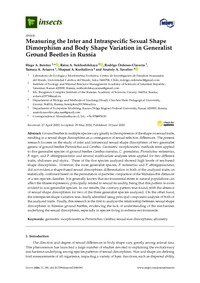Mostrar el registro sencillo de la publicación
Measuring the inter and intraspecific sexual shape dimorphism and body shape variation in generalist ground beetles in Russia
| dc.contributor.author | Benítez, Hugo A. | |
| dc.contributor.author | Sukhodolskaya, Raisa A. | |
| dc.contributor.author | Órdenes-Clavería, Rodrigo | |
| dc.contributor.author | Avtaeva, Tamara A. | |
| dc.contributor.author | Kushalieva, Shapaat A. | |
| dc.contributor.author | Saveliev, Anatoly A. | |
| dc.date.accessioned | 2020-11-09T12:43:35Z | |
| dc.date.available | 2020-11-09T12:43:35Z | |
| dc.date.issued | 2020 | |
| dc.identifier.uri | http://repositorio.ucm.cl/handle/ucm/3165 | |
| dc.description.abstract | Ground beetles in multiple species vary greatly in the expression of the shape on sexual traits, resulting in a sexual shape dimorphism as a consequence of sexual selection differences. The present research focuses on the study of inter and intrasexual sexual shape dimorphism of two generalist genera of ground beetles Pterostichus and Carabus. Geometric morphometric methods were applied to five generalist species of ground beetles Carabus exaratus, C. granulatus, Pterostichus melanarius, P. niger, and P. oblongopunctatus and several multivariate analyses were applied for two different traits, abdomen and elytra. Three of the five species analyzed showed high levels of sex-based shape dimorphism. However, the most generalist species, P. melanarius and P. oblongopunctatus, did not evidence shape-based sexual dimorphism differentiation in both of the analyzed traits, as statistically confirmed based on the permutation of pairwise comparison of the Mahalanobis distances of a sex–species classifier. It is generally known that environmental stress in natural populations can affect the fitness expression, principally related to sexual fecundity, being that this pattern is more evident in non-generalist species. In our results, the contrary pattern was found, with the absence of sexual shape dimorphism for two of the three generalist species analyzed. On the other hand, the interspecies shape variation was clearly identified using principal component analysis of both of the analyzed traits. Finally, this research is the first to analyze the relationship between sexual shape dimorphism in Russian ground beetles, evidencing the lack of understanding of the mechanism underlying the sexual dimorphism, especially in species living in extreme environments. | es_CL |
| dc.language.iso | en | es_CL |
| dc.rights | Atribución-NoComercial-SinDerivadas 3.0 Chile | * |
| dc.rights.uri | http://creativecommons.org/licenses/by-nc-nd/3.0/cl/ | * |
| dc.source | Insects, 11(6), 361 | es_CL |
| dc.subject | Geometric morphometrics | es_CL |
| dc.subject | Pterostichus | es_CL |
| dc.subject | Carabus | es_CL |
| dc.subject | Sexual size dimorphism | es_CL |
| dc.subject | Allometry | es_CL |
| dc.title | Measuring the inter and intraspecific sexual shape dimorphism and body shape variation in generalist ground beetles in Russia | es_CL |
| dc.type | Article | es_CL |
| dc.ucm.indexacion | Scopus | es_CL |
| dc.ucm.indexacion | Isi | es_CL |
| dc.ucm.doi | doi.org/10.3390/insects11060361 | es_CL |



